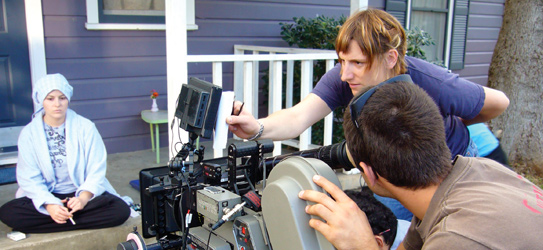STILLPOINT Archive: last updated 04/22/2013
by Jo Kadlecek
 Whether tracking the latest trends in Hollywood, connecting the impact of historic films to today’s work, or introducing her students to professional filmmakers and festivals, Virginia "Toddy" Burton’s work relies heavily on collaboration.
Whether tracking the latest trends in Hollywood, connecting the impact of historic films to today’s work, or introducing her students to professional filmmakers and festivals, Virginia "Toddy" Burton’s work relies heavily on collaboration.
Burton tries to steer students through a creative process that requires freedom and confidence. But the award-winning filmmaker describes the language of visual storytelling as a tightrope, where she needs to “hammer home” the traditional three-act structure for communication arts students while being vigilant about how technology is changing the art.
“There’s a tension in my field, because to do it well, you need to be embedded in a history that is millennia old—it’s storytelling, after all, and that includes going back to Aristotle, the Bible, and other great narratives to master the form,” she said. “At the same time, there’s the famous saying in the industry that ‘everyone wants something different.’”
Whether teaching video production, screenwriting, directing or criticism, Burton suggests the most innovative films are rooted in good storytelling; they’re authentic, vulnerable, personal and often messy. Knowing that, today’s filmmakers must also study the growing impact of the digital age and engage the strengths of video, which Burton calls a “no-excuses medium” because there’s no excuse not to make a movie. Consequently, her students experiment with the camera, improvise, and explore different angles and light to see how each shot can best communicate—or change—the story. She recruits top students to collaborate with her on her own productions, and pushes each class on to new projects quickly and honestly so as to keep perspective.
But they also study how business details such as film distribution are changing the modern art of the film. Filmmakers today are less focused on a theatrical release, Burton said, and more on building a following online, using social media to create their platform or network, and seeking non-conventional contracts such as video on demand. Each aspect of the industry requires constant attention: what movies make it to major festivals like Sundance, independent movies, or why certain films get the attention they do. Burton sees each as a tool.
“In some ways, it’s easier to be rigorous in teaching form and structure, because it has a right and wrong,” she said. “What is harder . . . and ultimately more rewarding is to provide that creative space, to help and come alongside the students as they’re trying to create something new. But in a Christian college environment, we have an opportunity to create that place—whether it’s heartbreaking or hilarious—because that’s what life is.”